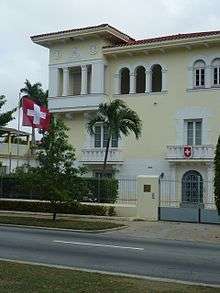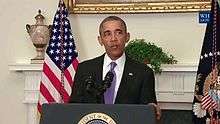Protecting power

In diplomatic usage, protecting power refers to a relationship that is initiated when a sovereign state does not have diplomatic representation in another country. A country may, in lieu of sending its own diplomatic representative to the receiving state, appoint a third state to be its protecting power. The third state is responsible for looking after the sending state's diplomatic property and the interests of its citizens in the hosting state.
It is common for protecting powers to be appointed when two countries break off diplomatic relations with each other. If the diplomatic breach was caused by the outbreak of war, the protecting power will also inquire into the welfare of prisoners of war and look after the interests of civilians in enemy-occupied territory.
The institution of protecting power dates back to the Franco-Prussian War of 1870 and was formalized in the Geneva Convention of 1929. Protecting powers are authorized in all four of the Geneva Conventions of 1949. In addition, the International Red Cross may itself be appointed a protecting power under Protocol I (1977). The practice of selecting a protecting power in time of peace was formalized in the Vienna Convention on Diplomatic Relations (1961).[2][3]
Diplomacy


The protecting power is appointed by the sending state and must also be acceptable to the host state. It must therefore maintain diplomatic relations with both states. In time of war, the Geneva Conventions also require that the protecting power be a neutral country. The specific responsibilities and arrangements are agreed between the protecting power, the sending state, and the host country.
In a comprehensive mandate, the protecting power carries out most diplomatic functions on behalf of the protected state. This is necessary when relations are so hostile that the sparring nations have no diplomatic or consular staff posted on each other's territory. For example, Sweden carries out limited consular functions for the United States, Canada, and Australia in North Korea.[4]
In other cases, the two nations have broken diplomatic relations, but are willing to exchange personnel on an informal basis. The protecting power serves as the mechanism for facilitating this exchange. The original embassy remains staffed by nationals of the protected state but is formally termed an "interests section" of the protecting power. For example, the Cuban Interests Section was staffed by Cubans and occupied the old Cuban embassy in Washington, D.C., but it was formally a section of the Swiss Embassy to the United States.
There is no requirement that the same protecting power be selected by both countries, although this is convenient for the purposes of communication. Each may appoint a different protecting power, provided that the choice is acceptable to the other state. There is also no requirement that a country select only one protecting power in the receiving country. During the Second World War, Japan appointed Spain, Sweden and Switzerland to be its protecting powers in the United States.[5]
Current mandates
| Protected state | Protecting power | Receiving state | Mandate | Notes |
|---|---|---|---|---|
| |
|
|
N/A | [3] |
| |
|
[6] | ||
| |
[7] | |||
| |
|
Comprehensive | [8] | |
| |
|
| ||
| |
|
N/A | See also: Interests Section of the Islamic Republic of Iran in the United States[9] | |
| |
|
|
Comprehensive | [4] |
| | ||||
| |
[3][4] | |||
| |
|
|
Interests section | [10] |
| |
|
[11] | ||
| |
[12] | |||
| |
|
Interests section | [11][13] | |
| |
|
[12] | ||
| |
Interests section | [3][11] |
History
The protecting power relationship originated in the Franco-Prussian War, when the belligerents expelled each other's diplomats and placed restrictions on enemy aliens. This made it necessary for belligerents to appoint protecting powers to represent their interests in enemy countries.[5] The energetic efforts of Elihu B. Washburne, the American Minister to France, set a precedent for the future actions of protecting powers in war. The United States had accepted a mandate to be the protecting power for the North German Confederation, and Washburne arranged for the evacuation of 30,000 German civilians who were in France at the outbreak of hostilities. As the only diplomat from a major power to remain in the city during the Siege of Paris, he was eventually charged with the protection of seven Latin American consulates and was responsible for feeding 3000 German civilians who were stuck in Paris during the Siege.[14][15]
The institution of protecting power became customary in international law but was not formalized until the Geneva Convention of 1929. The lack of formalization led to disputes over the rights and responsibilities of the protecting power. During the Second Boer War, the British Empire selected the United States to be its protecting power, but the Boers refused to allow the United States to transmit funds from the British government to prisoners of war. The Netherlands, acting as the protecting power for the Boer Republics, was also unable to secure an agreement to exchange the names of prisoners of war. Just two years later during the Russo-Japanese War, the belligerents agreed to exchange lists of prisoners, communicating through France as the protecting power for Russia, and the United States as the protecting power for Japan. The practice of swapping prisoner lists became customary and was eventually included in the Geneva Convention of 1929.[16]
World Wars
The United States was initially a popular choice for protecting power, going back to its protection of the North German Confederation during the Franco-Prussian War. The pinnacle of American diplomatic protection came during World War I, when the United States accepted reciprocal mandates from five of the largest belligerents on both sides: Britain, France, Austria-Hungary, Germany, and the Ottoman Empire. Between 1914 and 1917, the United States accepted a total of 54 mandates as protecting power.[14] When the United States entered the war on the Allied side in 1917, the American mandates were transferred to smaller neutrals, with the Netherlands, Spain, and Switzerland being popular choices.
The United States remained a popular choice at the start of World War II, accepting 75 mandates on behalf of Allied countries between 1939 and 1941. However, the United States was no longer seen as a disinterested neutral, and no Axis power asked the United States to be its protecting power.[14] Francoist Spain was neutral but Axis-leaning during the war, and the Netherlands were occupied by Germany. As a result, Switzerland and Sweden became the most popular choices for protecting power. Switzerland formally undertook 219 mandates for 35 states, and represented another eight states unofficially, while Sweden accepted 114 mandates for 28 states.[17]
After World War II
After 1945, the superpower rivalry of the Cold War led to changes in the institution of protecting power. The United States, which had accepted over 200 mandates as protecting power before 1945, was no longer seen as a disinterested third party and managed to secure only one mandate after 1945.[14] Instead, the United States had to appoint a protecting power to represent its interests over a dozen times since 1945.[18] Switzerland and Sweden both chose to remain non-aligned in the Cold War and refused to join any military alliances, leading to their continued popularity as protecting powers. Since 1945, Switzerland has held as many as 24 simultaneous mandates as protecting power.[11]
The interests section was born in the diplomatic aftermath of the Six-Day War of 1967. The two superpowers both participated unofficially in the war by supplying the militaries of their client states. Although the war led to a breach of diplomatic relations, the political situation made it unwise for the belligerents to expel all diplomats from the opposing superpower. After 1967, the Arab states allowed American diplomats to remain in their capitals as the U.S. interests section of the respective protecting power, while Israel allowed Soviet diplomats to remain in Tel Aviv as the Soviet interests section of the Finnish Embassy.[19]
The fiercest proxy wars of the Cold War were civil wars, including the Korean War and the Vietnam War. Because the principal belligerents each claimed to be the sole legitimate government of the unified country, they did not recognize each other and refused to maintain diplomatic relations with any countries that recognized the other side. This made it impossible to appoint a protecting power, as the belligerents had to agree on a country that had diplomatic relations with both sides. This difficulty was resolved by Protocol I to the Geneva Conventions, which stipulated that the belligerents should nominate protecting powers to the International Red Cross. The Red Cross would then approach any countries that were nominated on both lists, without the belligerents having to communicate with each other directly. If no arrangement could be made with a third country, then the Red Cross itself could act as the protecting power.[20]
Other meanings
- Historically a protecting power held a permanent protectorate over a weaker state, which in practice could constitute a form of colonial domination, in the logic of indirect rule.
- The term "friendly protection" also applied to "guarantor" state(s) vowing to prevent the protected state (or a specific part) being overrun by a third party.
Consular services
Certain countries may have agreements to provide limited consular services to the citizens of other countries. This does not necessarily constitute a protecting power relationship, as the host country may not have formally agreed, and there may in fact be diplomatic relations between the host country and the third country, but no physical representation. Without the agreement of the host country, consular officials in this role may not be recognized as representing the interests of another, and be limited to a "good offices" role.
- The United States provides consular services to citizens of the Federated States of Micronesia, the Republic of the Marshall Islands and the Republic of Palau, which had been part of a US Trust Territory.
- Certain Commonwealth countries, including Australia, New Zealand, Canada and the United Kingdom, have agreements in certain countries to provide consular services for citizens of the other countries where they do not have physical representation. The United Kingdom provides consular assistance to Canadians abroad where there is no Canadian mission, as stated in each Canadian passport. Canada provides consular assistance to Australian citizens to several states in Latin America and Africa; while Australian diplomatic missions reciprocate in several Asia-Pacific states.[21][22]
- Under Article 20 section 2c of the Treaty on the functioning of the European Union citizens of European Union countries may request consular services at the missions of other EU countries when their home country does not have a mission locally.[23]
- In 2006, the governments of Montenegro and Serbia adopted the Memorandum of Agreement between the Republic of Montenegro and the Republic of Serbia on Consular Protection and Services to the Citizens of Montenegro. By this agreement, Serbia, through its network of diplomatic and consular missions, provides consular services to the Montenegrin citizens on the territory of states in which Montenegro has no missions of its own.[24]
Notes and references
- 1 2 (French) Stéphane Bussard, "La voix suisse des États-Unis à Cuba se tait", Le Temps, Monday 20 July 2015.
- ↑ "Vienna Convention on Diplomatic Relations" (PDF). United Nations. 18 April 1961.
- 1 2 3 4 U.S. Department of State Foreign Affairs Manual. 7 FAM 1020.
- 1 2 3 "About the Embassy". Embassy of Sweden, Pyongyang.
In particular, Sweden functions as Protective Power for the United States, Australia and Canada, including consular responsibility for citizens.
- 1 2 Levie, Howard (1961). "Prisoners of War and the Protecting Power". American Journal of International Law. 55.
- ↑ Lee Berthiaume (March 8, 2012). "Australia secures assistance for citizens still in Syria". Postmedia News.
- ↑ Lee Berthiaume (March 7, 2012). "Australians left scrambling as Canada shutters embassy". Postmedia News. Archived from the original on October 6, 2014.
- ↑
- ↑ "Interests Section of the Islamic Republic of Iran". Embassy of Pakistan, Washington, D.C.
- ↑ "Georgia's Interests Section of the Swiss Confederation's Embassy to the Russian Federation". Ministry of Foreign Affairs of Georgia.
- 1 2 3 4 Swiss Federal Department of Foreign Affairs (4 April 2012). "Protective power mandates".
- 1 2 "Bons offices entres l'Arabie saoudite et l'Iran: feu vert des autorités saoudiennes". eda.admin.ch. Swiss Foreign Affairs Department. Retrieved 14 February 2016.
- ↑ "Embassy of Switzerland in Georgia, Russian Federation Interests Section". Ministry of Foreign Affairs of the Russian Federation.
- 1 2 3 4 Newsom, David D., ed. (1990). "Appendix A: The United States as a Protecting Power, by Country and Date". Diplomacy Under a Foreign Flag : when nations break relations. New York: St. Martin's Press. ISBN 0312040512.
- ↑ Hill, Michael, ed. (2012). Elihu Washburne: the Diary and Letters of America's Minister to France during the Siege and Commune of Paris. New York: Simon & Schuster. ISBN 9781451665307.
- ↑ Blake, James J. (1990). "Pragmatic Diplomacy: The Origins and Use of the Protecting Power". In Newsom, David D. Diplomacy Under a Foreign Flag: When Nations Break Relations. New York: St. Martin's Press. ISBN 0312040512.
- ↑ Schelbert, Leo (2014). "Good offices". Historical Dictionary of Switzerland. Rowman & Littlefield. p. 153. ISBN 9781442233522.
- ↑ Newsom, David D., ed. (1990). "Appendix B: Protecting Powers That Have Represented the United States, by Country and Date". Diplomacy Under a Foreign Flag : when nations break relations. New York: St. Martin's Press. ISBN 0312040512.
- ↑ Bergus, Donald C. (1990). "U.S. Diplomacy under the Flag of Spain, Cairo, 1967-74". In Newsom, David D. Diplomacy Under a Foreign Flag: When Nations Break Relations. New York: St. Martin's Press. ISBN 0312040512.
- ↑ Berridge, Geoff R. (2012). Embassies in Armed Conflict. New York: Continuum. ISBN 9781441104625.
- ↑ DFAIT Canada http://travel.gc.ca/assistance/embassies
- ↑ DFAT Australia http://www.dfat.gov.au/missions/
- ↑ Treaty on the Functioning of the European Union, Europa
- ↑ http://www.mip.gov.me/en/index.php/Bilateral-Relations/republic-of-serbia.html
External links
- Procedures, U.S. as Protecting Power (PDF) U.S. State Department